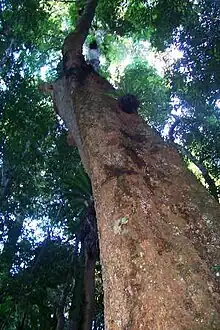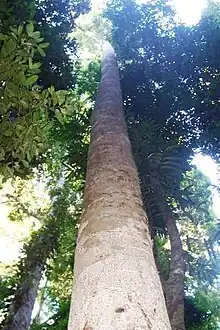| Boorganna Nature Reserve New South Wales | |
|---|---|
 Southern angle headed dragon in the reserve | |
 Boorganna Nature Reserve | |
| Nearest town or city | Comboyne |
| Coordinates | 31°38.015′S 152°23.74′E / 31.633583°S 152.39567°E |
| Established | 12 March 1904[2] |
| Area | 4 km2 (1.5 sq mi)[3] |
| Managing authorities | NSW National Parks & Wildlife Service |
| Website | Boorganna Nature Reserve |
| See also | Protected areas of New South Wales |
The Boorganna Nature Reserve is a protected nature reserve located northwest of Taree on the Comboyne Plateau in New South Wales, Australia. The 396-hectare (980-acre) reserve, managed by the NSW National Parks & Wildlife Service, was gazetted in 1904 and is the second oldest nature reserve in the state. The reserve features various forest types, including stands of sub tropical rainforest of which the large rosewood, yellow carabeen and small leaf fig are particularly noteworthy.[3] The reserve is a remnant of the former extensive rainforest on the Comboyne Plateau. The plateau was cleared between 1900 and 1925. Australian red cedar was logged in the area in the nineteenth century. Originally proposed to be part of the world heritage rainforest group.[4] The exploration, knowledge, uses and history of this area by Indigenous Australians is not well known in the present day. Boorganna Nature Reserve was proposed, but rejected for inclusion on the UNESCO World Heritage, due to being geographically isolated from other rainforests in the group.
Location and features
A picnic area next to the forest provides chairs and tables for visitors. Walking trails, a lookout to Rawson Falls and an information board is also provided. Picnics provide a pleasant view of the nearby area. A variety of small birds appear from the edge of the forest. The reserve is situated 32 kilometres (20 mi) north of Taree, with access via Wingham. Form the southwest, the reserve is situated 35 kilometres (22 mi) from Wauchope; and is approximately 6 kilometres (3.7 mi) from the town of Comboyne. The reserve lies to the south of the Oxley Highway, enabling access via Port Macquarie and Tamworth.[2]
Geology and climate
The reserve receives an average annual rainfall of 1,930 millimetres (76 in).[2][5] The climate is sub tropical, though at an elevation ranging from 360 to 732 metres (1,181 to 2,402 ft),[2] it is cooler than at the coast nearby. Soils are derived from Miocene basalt, which provide a deep red loam. Below the basalt are less fertile sedimentary rocks. The western area of the reserve where it adjoins the Great Dividing Range has partly eroded, forming areas of cliffs, rocks and shallow soils. Deep gullies, isolated hills and sharp edged rocky ridges occur here. Rocks include pebbly mudstone, conglomerate siltstone and shale. Serpentinite outcrops can also be seen.
Fauna
Animals are seldom seen in the rainforest, being nocturnal. However, many species live in the reserve. Such as a bats, wallabies, possums, gliders, spotted quoll, platypus, bandicoots, pademelons, bush rats, snakes, lizards and antechinus.
Bird life is varied and extensive with around a hundred species recorded. Many rainforest pigeons frequent the reserve such as the rose crowned fruit dove and wompoo fruit dove.[2] As well as other seldom seen species such as the noisy pitta, green catbird, and figbird.
Invertebrate biology is not so well understood. However, a vast number of insects, arachnids, molluscs, worms and other small creatures live in the rainforest. Leeches are often noticed by bushwalkers after rain. Red triangle slugs and blue planarian live on the forest floor. Tree dwelling snails may be found here.
Flora
Sub tropical rainforest

The jungle or sub tropical rainforest features a dark forest with many large trees. Several species grow to great height and a broad trunk diameter, such as yellow carabeen, small leaf fig, Moreton Bay fig, rosewood, black booyong, giant stinging tree, pigeonberry ash, brush box and silver quandong. Other smaller plants of interest include the walking stick palm and the Macleay laurel.[6][7]
Boorganna Nature Reserve features several plants at or near their most southern limit of natural distribution. Such as the sour cherry, purple cherry, white apple, turnipwood and the red carabeen.[2]
The Antarctic beech is now considered extinct at Boorganna. However, some of its associated species still persist at Boorganna.[8] Antarctic Beech has been recorded at four nearby sites in the Comboyne area, growing in cool stream side rainforests at elevations ranging from 570 to 630 metres above sea level.[9][10]
Warm temperate rainforest
Below the more fertile basalt is a poorer soil type. Warm temperate species are more frequently seen here, such as the coachwood, watergum, sassafras and lilly pilly.[11][2][7]
Gully rainforest
Gully rainforest occurs south of Mumford's Creek, in steep sided narrow gullies. Plant species from the sub-tropical and warm temperate rainforest occur here. They include whalebone tree, walking stick palms and the Bangalow palm.[2]
Dry rainforest
Where the soil is shallow, and conditions are exposed to winds and fire is infrequent, dry rainforest occurs. Rainforest tree species in this area include the grey myrtle and shatterwood.[2]
Eucalyptus forest
Eucalyptus forest occurs in areas where fires often occur. In the wetter areas are Sydney blue gum, brush box, tallowwood, and New England blackbutt. Some of the tallowwoods are particularly tall and impressive in this area. The drier eucalyptus areas are subject to higher winds, frequent fires and shallow less fertile soils. Trees here include the black sheoak.[2]
Fungi
At Boorganna Nature Reserve fungi is noticeable and often colourful and spectacular, particularly after rain in the autumn.[12] The bracket rainbow fungus often appears on fallen logs.
Photos from Boorganna Nature Reserve
 Picnic area by the carpark at Boorganna Nature Reserve
Picnic area by the carpark at Boorganna Nature Reserve Rawson Falls
Rawson Falls base of Rawson Falls
base of Rawson Falls Sour cherry at Boorganna Nature Reserve
Sour cherry at Boorganna Nature Reserve Small leaf fig at Boorganna Nature Reserve
Small leaf fig at Boorganna Nature Reserve Small leaf fig bark at Boorganna Nature Reserve
Small leaf fig bark at Boorganna Nature Reserve Rosewood at Boorganna Nature Reserve
Rosewood at Boorganna Nature Reserve Pigeonberry ash at Boorganna Nature Reserve
Pigeonberry ash at Boorganna Nature Reserve White beech at Boorganna Nature Reserve
White beech at Boorganna Nature Reserve Rainbow bracket fungi at Boorganna Nature Reserve
Rainbow bracket fungi at Boorganna Nature Reserve Fungi at Boorganna Nature Reserve
Fungi at Boorganna Nature Reserve
See also
References
- ↑ "Boorganna". Protected Planet. Retrieved 30 December 2018.
- 1 2 3 4 5 6 7 8 9 10 Boorganna Nature Reserve: Plan of Management (PDF) (PDF). Government of New South Wales. 12 December 2005. ISBN 1-74122-082-3. Retrieved 14 September 2014.
{{cite book}}:|work=ignored (help) - 1 2 "Boorganna Nature Reserve". Office of Environment & Heritage. Government of New South Wales. Retrieved 14 September 2014.
- ↑ Geoff Williams, former CEO of Australia Heritage. Who said that "Brussels saw them as disjunct units rather than a continuum". So, an omission based on ignorance, bias or whim. (Personal Communication).
- ↑ "Peace, Quiet & Fresh Mountain Air". Comboyne. Archived from the original on 25 February 2012. Retrieved 9 August 2012.
- ↑ Floyd, A. G. (1990). Australian Rainforests of New South Wales. Vol. 2. p. 39. ISBN 0-949324-32-9.
- 1 2 Webb, Len (1 October 1959). "A Physiognomic Classification of Australian Rain Forests". Journal of Ecology. British Ecological Society : Journal of Ecology Vol. 47, No. 3, pp. 551-570. 47 (3): 551–570. doi:10.2307/2257290. JSTOR 2257290.
- ↑ "Boorganna Nature Reserve" pamphlet 1977, National Parks & Wildlife Service
- ↑ "Lost & Found, Nothofagus moorei at Comboyne. authors C.L. Bale & J.B. Williams" (PDF). Cunninghamia. Archived from the original (PDF) on 16 March 2017. Retrieved 21 February 2017.
- ↑ Floyd, A. G. (2008). Rainforest Trees of Mainland South-eastern Australia (2nd, Revised ed.). Lismore, New South Wales: Terania Rainforest Publishing. p. 272. ISBN 978-0-958943-67-3. Retrieved 20 February 2017.
- ↑ Floyd, A. G. (1990). Australian Rainforests of New South Wales. Vol. 2. p. 120. ISBN 0-949324-32-9.
- ↑ "Boorganna Nature Reserve - visitor information". National Parks & Wildlife Service of New South Wales.
External links
- "Boorganna Nature Reserve". Office of Environment & Heritage. Government of New South Wales.
- "Boorganna Nature Reserve". Comboyne.org. Archived from the original on 13 September 2009. Retrieved 4 July 2009.
- Boorganna Nature Reserve: Plan of Management (PDF) (PDF). Government of New South Wales. 12 December 2005. ISBN 1-74122-082-3.
{{cite book}}:|work=ignored (help)